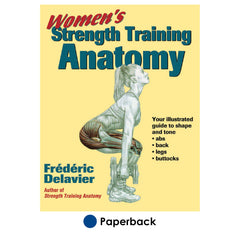See the skeletal differences between women and men
This is an excerpt from Women's Strength Training Anatomy by .
The morphological differences between women and men are the result of differences in the volume and proportion of similar anatomical features. Generally speaking, the female skeleton is not as massive; it is smoother and more delicate with impressions—hollows or bumps—that serve as muscle insertions or provide passage for tendons, which are less accentuated. (The more highly developed musculature in men marks the skeleton more.) The female thoracic cage is generally more rounded and not as big as in the male. Proportionately, the skeletal width of the shoulders is the same as in the male, but the larger muscular development of the latter makes it seem wider. The lumbar curve is greater in women and the pelvis is tilted anteriorly (anteversion), which makes for the sway-backed appearance often found in women. If the waist in women is longer and smaller, it is because the thorax is more constricted at the base and the pelvis is generally not as high.
The most important difference between the male and female skeletons is found at the level of the pelvis. The female pelvis is adapted for gestation: it is not as high and is proportionately wider than that of the male. The sacrum of the female is wider and the pelvic ring is wider and more circular to facilitate the passage of the newborn. As the pelvic ring is wider, the acetabula (the fossa in which the heads of the femurs lodge) are farther apart, which increases the distance between the greater trochanters and consequently the width of the hips.
Greater hip width in women influences the position of the femurs, which are often more angled than in men, giving them a slight X shape.
A wide pelvis with a significant angle of the femur can provoke genu valgum, accentuated all the more by the hyperlaxity toward which women tend. The legs then take on a typical X shape: the articulation at the knee is excessively solicited; the medial collateral ligament is overstretched; and the lateral meniscus, the cartilage-covered articular surfaces of the external condyle of the femur, and the lateral tuberosity of the tibia are subjected to excessive loads, which may lead to premature wear.
Pathological genu valgum is accompanied by medial collapse at the ankle and the disappearance of the plantar arch (flat foot), which may involve pain because of excessive stretching of certain muscles in the sole of the foot.
It is very important to take into account the individual morphologies and to remember that women are more often prone to genu valgum pathologies, whereas men more frequently suffer from bow-legs (genu varum). People with very noticeable genu valgum should therefore work out carefully, avoid training with heavy weights, and always perform the movements so as to avoid impacts that would aggravate knee and ankle problems.
This is an excerpt from Women's Strength Training Anatomy.


Get the latest insights with regular newsletters, plus periodic product information and special insider offers.
JOIN NOW
Latest Posts
- Authenticity was key to McKinney’s NIL success
- AI—A new tool for sport PR pros
- Essential skills for sport PR practitioners
- Employ these tactics when pitching a story to the media
- How does ergonomic analysis and intervention enhance safety and reduce injury risk?
- Common movement patterns in competitive cycling


